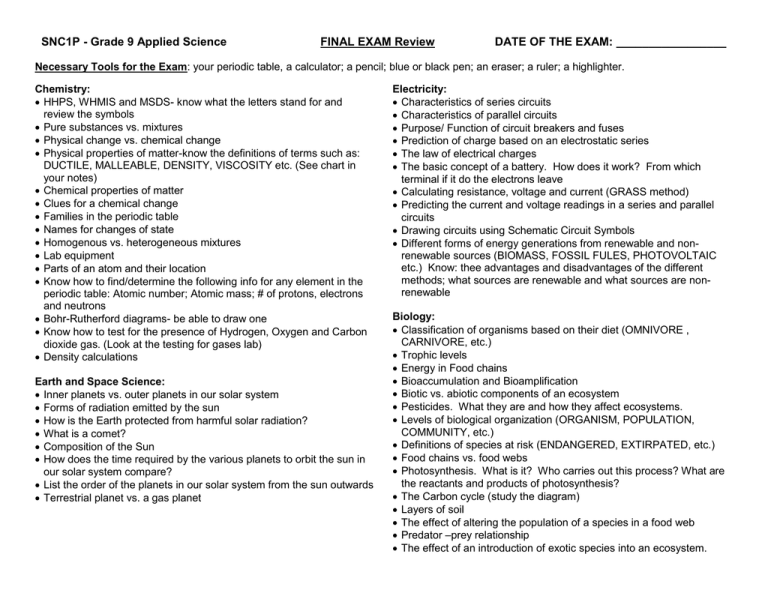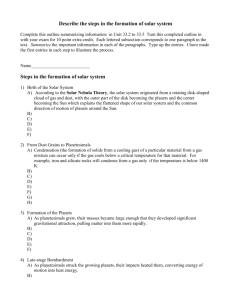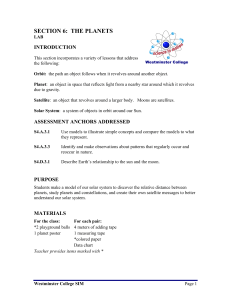SNC1P - Grade 9 Applied Science FINAL EXAM Review
advertisement

SNC1P - Grade 9 Applied Science FINAL EXAM Review DATE OF THE EXAM: _________________ Necessary Tools for the Exam: your periodic table, a calculator; a pencil; blue or black pen; an eraser; a ruler; a highlighter. Chemistry: HHPS, WHMIS and MSDS- know what the letters stand for and review the symbols Pure substances vs. mixtures Physical change vs. chemical change Physical properties of matter-know the definitions of terms such as: DUCTILE, MALLEABLE, DENSITY, VISCOSITY etc. (See chart in your notes) Chemical properties of matter Clues for a chemical change Families in the periodic table Names for changes of state Homogenous vs. heterogeneous mixtures Lab equipment Parts of an atom and their location Know how to find/determine the following info for any element in the periodic table: Atomic number; Atomic mass; # of protons, electrons and neutrons Bohr-Rutherford diagrams- be able to draw one Know how to test for the presence of Hydrogen, Oxygen and Carbon dioxide gas. (Look at the testing for gases lab) Density calculations Earth and Space Science: Inner planets vs. outer planets in our solar system Forms of radiation emitted by the sun How is the Earth protected from harmful solar radiation? What is a comet? Composition of the Sun How does the time required by the various planets to orbit the sun in our solar system compare? List the order of the planets in our solar system from the sun outwards Terrestrial planet vs. a gas planet Electricity: Characteristics of series circuits Characteristics of parallel circuits Purpose/ Function of circuit breakers and fuses Prediction of charge based on an electrostatic series The law of electrical charges The basic concept of a battery. How does it work? From which terminal if it do the electrons leave Calculating resistance, voltage and current (GRASS method) Predicting the current and voltage readings in a series and parallel circuits Drawing circuits using Schematic Circuit Symbols Different forms of energy generations from renewable and nonrenewable sources (BIOMASS, FOSSIL FULES, PHOTOVOLTAIC etc.) Know: thee advantages and disadvantages of the different methods; what sources are renewable and what sources are nonrenewable Biology: Classification of organisms based on their diet (OMNIVORE , CARNIVORE, etc.) Trophic levels Energy in Food chains Bioaccumulation and Bioamplification Biotic vs. abiotic components of an ecosystem Pesticides. What they are and how they affect ecosystems. Levels of biological organization (ORGANISM, POPULATION, COMMUNITY, etc.) Definitions of species at risk (ENDANGERED, EXTIRPATED, etc.) Food chains vs. food webs Photosynthesis. What is it? Who carries out this process? What are the reactants and products of photosynthesis? The Carbon cycle (study the diagram) Layers of soil The effect of altering the population of a species in a food web Predator –prey relationship The effect of an introduction of exotic species into an ecosystem.





